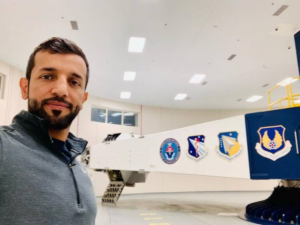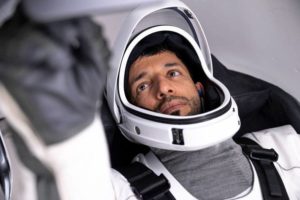In a case of a childhood dream coming true, Griffith University alumnus Dr Sultan Al Neyadi is heading to the International Space Station.
He will lift off in a SpaceX Falcon 9 rocket from Florida’s Kennedy Space Centre, serving as mission specialist on the NASA-SpaceX Crew 6 mission, along with pilot Warren Hoburg, commander Steve Bowen and Russian cosmonaut Andrey Fedyaev.
Chosen from a pool of more than 4000 applicants, Dr Al Neyadi will be the United Arab Emirates’ second-ever astronaut, and the first Emirati astronaut to take on the six-month long mission.
“I remember watching the night sky when I was a child, when we could see our magnificent galaxy, the Milky Way much more clearly, trying to count the stars with my brothers and sisters,” Dr Al Neyadi said.

Dr Al Neyadi training in a centrifuge, a robotic machine that simulates gravitational forces. Photo: Sultan Al Neyadi Twitter
“Although it seemed impossible at the time, the idea of visiting these stars captured my imagination.
“It was my dream to become a pilot and an astronaut.”
Although Dr Al Neyadi found himself drawn to engineering, and after spending 20 years serving in the military, he never let go of his childhood dream.
First studying electronics and communications engineering in the United Kingdom, he then completed a master’s degree in information and network security and a PhD in data leakage prevention technology with Griffith University.
“I remember meeting some of the other applicants, who were mostly pilots, and thinking that as an engineer, I’d have very little chance of being selected, but they looked at the candidates as a whole, including our academic background, work experience, physical shape, and medical status.”
Since being selected almost five years ago, Dr Al Neyadi has been in continuous, intense training, where he’s had to learn a range of new skills and information, and has been preparing his physical readiness.
Having no aviation background, he’s learnt to fly jets, to SCUBA dive and spend six hours under water in a neutral buoyancy lab, operate robotics, and even conduct medical procedures in case of an emergency.

Dr Al Neyadi in training. Photo: Nasa / SpaceX
He’s also delved into science, as he’ll be conducting scientific sampling on himself while on board to see the impact of space and weightlessness on human bodies.
He’ll measure and record his vital signs, vascular system, hearing, vision, bone density, body mass and DNA ageing to determine the feasibility of spending long periods in space, and establish the impact of long space missions should we one day go to Mars or need to spend time in a lunar habitat.
“It is very challenging training and staying ready for such a long time is very tough, but to me the hardest part has been staying away from my family for such long periods,” he said.
“I’ve been mostly overseas, training in Russia and the US so that’s been very difficult for me, but we can take some personal belongings to the ISS, so I will be taking my wedding ring, some of my kids’ Lego characters, and their favourite book to read on board.
“It’s a great privilege to go on this mission, but also a great responsibility.
“It’s an advancement of science and technology, but also spreading enthusiasm among youngsters and being a good role model.”
